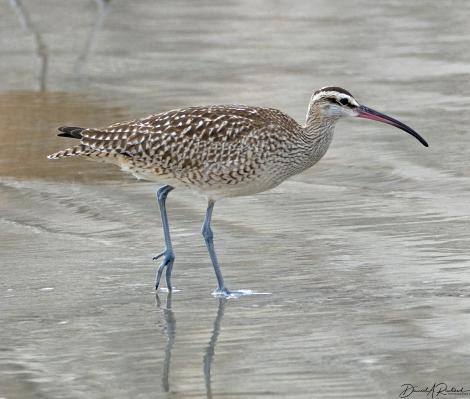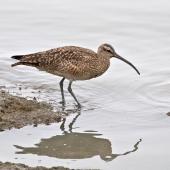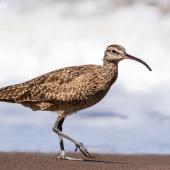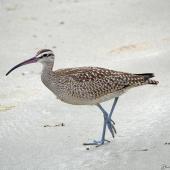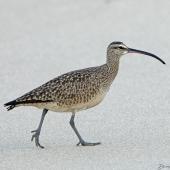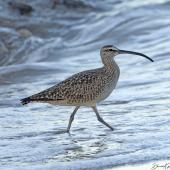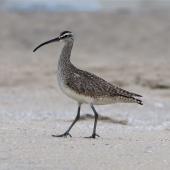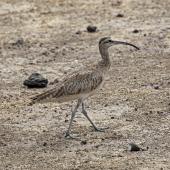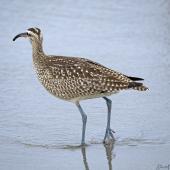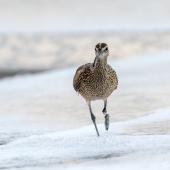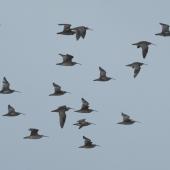American whimbrel
Numenius hudsonicus Latham, 1790
Order: Charadriiformes
Family: Scolopacidae
Other names: Hudsonian whimbrel
Geographical variation: Often considered conspecific with Eurasian whimbrel (Numenius phaeopus)
The American whimbrel is a large, migratory shorebird with only a single confirmed record from New Zealand. It is very similar to the Eurasian whimbrel, which reaches New Zealand annually in small numbers.
Identification
Both the American whimbrel and Eurasian whimbrel are somewhat larger than bar-tailed godwits and recognisable by their down-curved bill and pale stripe down the centre of the crown. They are mottled dark brown above, pale below, with much brown streaking on the throat and breast. The head is conspicuously striped, with a pale eyebrow stripe separating the dark eye-stripe and side-crown, and another pale stripe down the centre of the crown. The American whimbrel always has a dark rump and back (this is variable in Eurasian whimbrel, most of which have a pale blaze up the back visible in flight). American whimbrels have a cinnamon-buff toned underwing (similar to bristle-thighed curlew) while Eurasian birds have a more greyish tone.
Voice: Both whimbrel species have a distinctive seven note whistle: ti-ti-ti-ti-ti-ti-ti.
Similar species: eastern curlew is larger with proportionately much longer bill and no crown stripe. Little whimbrel has crown stripe but bill is finer and only slightly down curved. Bristle-thighed curlew is similar in size and structure but has overall cinnamon-buff colouration, a plain (unbarred) orange-buff rump, and a very different call.
Distribution and habitat
Breeds on Arctic tundra in North America, in northern Alaska to western Yukon, and western Hudson Bay. Winters on estuaries and soft shorelines from Oregon and north Carolina south to Tierra del Fuego. Very rare vagrant to New Zealand and Australia.
New Zealand records
A single accepted record: Wairau Bar, Marlborough, December 1873 (Te Papa specimen NMNZ OR.000111). Also a possible sight record from Firth of Thames in May 1964. As dorsal plumage colour is no longer recognised as a reliable character for separating the two whimbrel species, all other New Zealand records of American whimbrel are considered to be unverified.
Population
About 80,000 birds estimated.
Threats and conservation
Several important over-wintering sites are under severe threat from reclamation and pollution.
Breeding
American whimbrels breed on Arctic tundra across North America. A clutch of 4 eggs is laid in a bare scrape.
Behaviour and ecology
American whimbrels occur singly or in small flocks on estuaries when away from their breeding grounds, often associating with other waders. In New Zealand, American whimbrels are most likely to associate with Eurasian whimbrels and bar-tailed godwits.
Food
In the non-breeding season whimbrels of both species feed on a wide range of estuarine invertebrates including worms but particularly crabs.
Weblinks
http://www.environment.gov.au/cgi-bin/sprat/public/publicspecies.pl?taxon_id=849
References
del Hoyo, J.; Elliott, A.; Sargatal, J. (eds). 1996. Handbook of birds of the world. Vol. 3, hoatzin to auks. Lynx Edicions, Barcelona.
Hogg, M.J.; Brown, B. 1966. American whimbrel (Hudsonian curlew) in Firth of Thames. Notornis 13: 67–68.
Medway, D.G. 2010. Charadriiformes (waders). Pp. 191-223. In: Checklist Committee (OSNZ) 2010. Checklist of the birds of New Zealand, Norfolk and Macquarie Islands, and the Ross Dependency, Antarctica (4th edn). Ornithological Society of New Zealand & Te Papa Press, Wellington.
Oliver, W.R.B. 1955. New Zealand birds. Second edition. A.H. & A.W. Reed: Wellington. 661 pp.
Ruthrauff, D.,R.; Harwood, C.M.; Tibbitts, T.L.; Warnock, N.; Gill, R.E. 2021. Diverse patterns of migratory timing, site use, and site fidelity by Alaska-breeding whimbrels. Journal of Field Ornithology 92 (2): 156-172. DOI: 10.1111/jofo.12365
Sangster, G.; Collinson, J.; Crochet, P-A.; Knox, A.G.; Parkin, D.T.; Svensson, L.; Votier, S.C. 2011. Taxonomic recommendations for British birds: seventh report. Ibis 153: 883-892.
Smith, F.M.; Watts, B.D.; Duerr, A.E. 2011. Using satellite and radio telemetry to examine stopover and migration ecology of the whimbrel: 2009-2011 Report. CCBTR-11-05. Center for Conservation Biology Technical Report Series. College of William and Mary, Williamsburg, VA. 20 pp.
Tomkovich, P.S. 2008. A new subspecies of the whimbrel (Numenius phaeopus) from central Siberia. Zooloičeski Žurnal 87: 1092-1099 [in Russian; English abstract].
Zink, R.M.; Rohwer S.; Andreev, A.V.; Dittmann, D.L. 1995. Trans-Beringia comparisons of mitochondrial DNA differentiation in birds. Condor 97: 639-649.
Recommended citation
Melville, D.S.; Miskelly, C.M. 2022. American whimbrel. In Miskelly, C.M. (ed.) New Zealand Birds Online. www.nzbirdsonline.org.nz
American whimbrel
- Breeding season
-
- Jul
- Aug
- Sep
- Oct
- Nov
- Dec
- Jan
- Feb
- Mar
- Apr
- May
- Jun
- Egg laying dates
-
- Jul
- Aug
- Sep
- Oct
- Nov
- Dec
- Jan
- Feb
- Mar
- Apr
- May
- Jun




